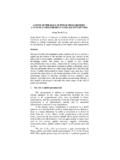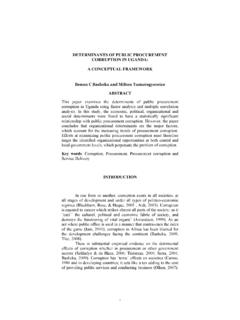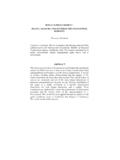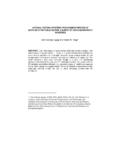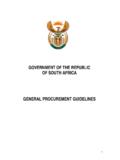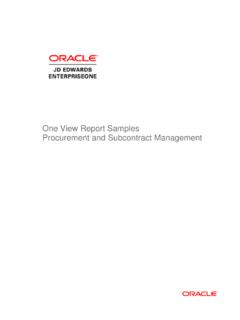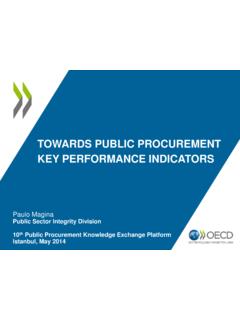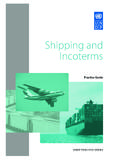Transcription of PROCUREMENT PROCESSES AND PERFORMANCE: …
1 1 PROCUREMENT PROCESSES AND performance : efficiency AND EFFECTIVENESS OF THE PROCUREMENT FUNCTION Patrick Kakwezi and Sonny Nyeko Kakwezi is a Lecturer in Department of PROCUREMENT and Logistics University Business School, Box 1337, Kampala, 256 41, Uganda Tel: +256 772 339 019, Fax: + 256 41 4505921, Email: Nyeko is a lecturer in the Department of Business Computing. Makerere University Business School, Box 1337, Kampala, 256 41, Uganda Tel: +256 772 590 832, Fax: + 256 41 4505921, Email: Abstract For decades PROCUREMENT performance has been attracting great attention from practitioners, academicians and researchers due to poor performance resulting from non adherence to proper PROCESSES and procedures.
2 This paper aims at identifying financial and non financial measures that can contribute to improved performance of the PROCUREMENT function. Literature suggests that PROCUREMENT efficiency and PROCUREMENT effectiveness of the purchasing function are measures of PROCUREMENT performance . A survey instrument was developed and administered to a public entity in Uganda with a view to establish the importance of financial and non financial measures in the performance of the PROCUREMENT function.
3 The paper concludes that other than financial measures, non financial measures also contribute significantly in the PROCUREMENT process and performance . Key words: PROCUREMENT Process, Purchasing performance , efficiency and effectiveness. INTRODUCTION The PROCUREMENT function has not been given the recognition it deserves in developing countries, in most public entities, regardless of the effort by the partners like the World Bank, the International Trade Organisation, the United Nations Conference on Trade and Development, the World Trade Organisation and, others.
4 This could be deliberate or sheer ignorance on the value the PROCUREMENT function could contribute to any organization (Telgen, Zomer, & de Boer, 1997). While functions like 2 Human Resource (HR) and Finance can have their performance measured, this is not the case with the PROCUREMENT function. The failure to establish performance of the PROCUREMENT function has led to irregular and biased decisions that have costly consequences to every entity. The need to have coherent methods of performance of the PROCUREMENT function in public entities, particularly in developing countries, has never been as sound as it is now.
5 Delaying will worsen the already deteriorating performance , loss of professionals, and organisations will continue incurring unnecessary costs (DCD/DAC, 2003). However, it is important that appropriate performances are implemented. It should not be any performance . The issue of basing on financial performance and neglecting or ignoring non financial performance is not helping the PROCUREMENT function because only partial performance is considered (Lardenoije, Van Raaij, & Van Weele, 2005). CURRENT ISSUES IN PUBLIC PROCUREMENT FOR DEVELOPING COUNTRIES In most developing countries, the PROCUREMENT function is transitioning from a clerical non strategic unit to an effective socio-economic unit that is able to influence decisions and add value (Knight, Harland, Telgen, Thai, Callender, & Mcken, 2007; and Facolta di Economia, 2006).
6 Developing countries in one way or another have reformed their public PROCUREMENT regulations. The reforms have not been limited to regulations only, included public PROCUREMENT process, methods, PROCUREMENT organisational structure, and the workforce. The reforms have been as a result of joint effort with various development partners like the World Bank, International Trade Centre, WTO, and UNCTAD varying from country to country. None the less, most developing countries are facing a problem of rapid changes in public PROCUREMENT requirements.
7 The changes are impacting pressure on how the PROCUREMENT function performs its internal and external PROCESSES and procedures in order to achieve its objectives. The ability to realize PROCUREMENT goals is influenced by internal force and external force. Interactions between various elements, professionalism, staffing levels and budget resources, PROCUREMENT organisational structure whether centralized or decentralized, PROCUREMENT regulations, rules, and guidance, and internal control policies, all need attention and influence the performance of the PROCUREMENT function.
8 In addition, public PROCUREMENT is faced by the challenges imposed by a variety of 3 environment factors (external factors) such as market, legal environment, political environment, organisational and socio-economic environmental factors. FACED ISSUES IN PUBLIC PROCUREMENT IN UGANDA Historically, public entities of Uganda have been known for their poor performance and corruption, resulting from non adherence to PROCESSES and procedures, poor resource utilization, poor personnel management and training, inadequate payment and benefits.
9 It is on this basis that the government of Uganda, in 1989, set up the Public Service Review and Reorganization Commission (PSRRC), under the Ministry of Public Service, to examine and propose recommendations on public service improvement (Ministry of Public Service, 2008). The ultimate goal was to improve the general service delivery to the public, create efficiency and effectiveness based on transparency in PROCESSES and procedures, performance evaluation systems and clear organizational goals and objectives.
10 The results of the commission led to the establishment of government agencies by law: Public PROCUREMENT and Disposal of Public Assets Authority, Uganda Revenue Authority, National Environmental Management Authority, Civil Aviation Authority, National Agricultural Research Organization, Uganda Wildlife Authority, Inspector General of Government and many others. Particularly, the PPDA Act (2003) in Uganda describes how public PROCUREMENT may be conducted through the PROCUREMENT cycle. The roles and responsibilities of public entities are limited to the PROCUREMENT cycle presented in appendix 1 above in executing their activities.
